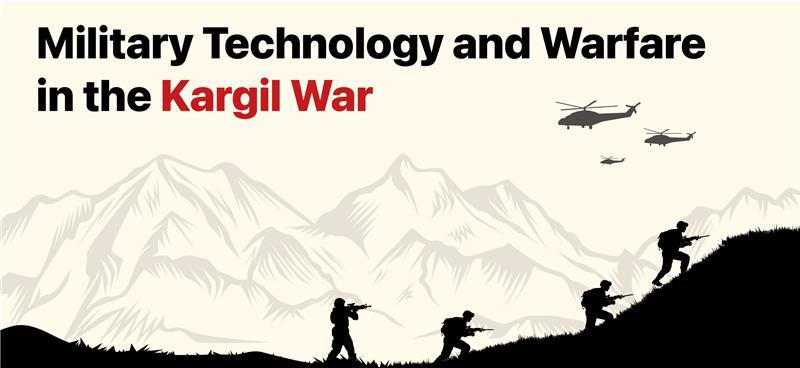Military Technology and Warfare in the Kargil War
Blogs Home
- 26 Jul 2023

Every year on July 26, Kargil Vijay Diwas, also known as Kargil Victory Day, is observed to remember India's momentous victory over Pakistan in the Kargil War in 1999. As part of "Operation Vijay", the Indian Army successfully drove Pakistani invaders out of Tiger Hill and other locations on the Indian side of the Line of Control (LoC) during this conflict. In this blog, the aspects of Kargil warfare, including the military technology used would be explored.
The Kargil War: Causes and Significance of the Region
In the summer of 1999, the Kargil War took place between India and Pakistan. It started as early as May 8 and ceased by July 14. This war left hundreds of soldiers dead and thousands of them wounded, leaving Pakistan defeated. The war was initiated by Pakistan and is believed that the major motive behind this incursion was to bring the issue of Kashmir to the forefront.
The terrain of LoC which is rugged and gets heavy snowfall was exploited for this purpose. This was based on the belief that the Indian Army would not be able to track the intrusion or even if it does, it would be difficult to move due to heavy snowfall. This calculated move was based on the intention to gain access to strategic locations across the LoC, which would provide Pakistan with a dominating position. Kargil is the second largest town in the Ladakh Region and is near Srinagar, Leh and other such areas. Being on the Srinagar-Leh National Highway, the region of Kargil is vital for transport and trade.
Military Strategies and Planning
The Pakistan military aimed to carry out invasions and used the challenges of the terrain to its advantage. Since the region gets a heavy snowfall, the Pakistan army assumed that the Indian army would not be able to respond or even if it does, the reaction would be slow. The terrain where "Operation Vijay'' was battled, lies at a high altitude and the temperature goes to even -60°C. The intrusions included both the Mujaheddin groups and members of the Pakistan Army's Northern Light Infantry. (NLI)
The Indian Army had a variety of challenges in front of them. For starters, the region of Kargil is cold, and it is not hospitable. Regardless, by May 26, 1999, the Indian army began its operation called "Operation Vijay". The army moved towards the positions under intrusion by the Pakistan army. The tactics employed by the Pakistani Army included camouflaging which allowed them to conceal themselves and surprise attack. Although initially, they denied involvement, the Pakistani Army used the intrusions and the high altitude to their advantage.
Role of Technology in the Kargil War
To gain an advantage and conquer this difficult battle on challenging terrain, the Indian armed forces used technology that was capable of surveillance and communication. Unmanned Aerial Vehicles (UAVs) and Unmanned Aerial Surveillance (UAS) systems made it possible for the army to know the movements of enemy troops and organise themselves accordingly. Communication and technologies are important elements that can determine the course of the war.
There is no doubt that synchronisation and effective coordination are possible only when there is communication between the troops on the ground, with the other units as well as from their places of command, the headquarters. At the same time, the Indian army had to make sure that the communication systems employed were secure and for which they relied on satellite systems.
Air Power and Aerial Operations
The Air Force played a crucial role in supporting the Indian Army to fight against intruders. An operation whose code name was "Operation Safed Sagar" was launched by the Air Force. The biggest challenge, however, was the terrain of the Kargil and the fact that IAF had to stay within the Line of Control.
In high-altitude warfare, the risk is immense. Kargil being at 4500-5500 metres above sea level, the aircraft was supposed to be at an altitude of 6100 metres. Ground attack aircraft MiG-21s, MiG-23s, MiG-27s, Mirage 2000 and Jaguars were deployed for this purpose. It is said that the airstrikes determined the conflict. Strikes on the enemy camps severely limited their ability to make necessary supplies. This was the first time the Indian Air Force fought in a limited war zone and at such a high altitude.
Infantry Operations and Role of Artillery and Missile Systems
The War of Kargil is a perfect example of why training is necessary for troops to operate effectively in mountainous regions. The infantry had to acclimatise by the harsh coldness, as low as -60°C. The coordination among infantry, and artillery was particularly beneficial to counter the intruders and leave them defeated. With coordinated efforts, the first ridgeline fell which was the Tololing in the Drass Sub-sector and subsequently, the Tiger Hill was reclaimed. The Gun-Hill, previously known as Point 4875 was recaptured by July 7, 1999.
The Regiment of Artillery played a very important role to deal with enemy troops through their accuracy in firepower. Along with the infantry, the artillery made sure to respond to Pakistan's intrusion even though the latter had never been deployed at a height that Kargil had. True to their motto of 'Sarvatra Izzat-O-Iqbal' the Regiment of Artillery showed the honour and glory it carries.
As Maj Gen Jagjit Singh writes in the Indian Defence Review, ‘’Direct shooting, particularly by the Bofors, spelt terror amongst the defenders and had a devastating effect in the destruction of enemy bunkers’’. Furthermore, he informs that the Indian artillery fired over 2,50,000 shells, bombs and rockets during the Kargil conflict and approximately 5,000 artillery shells, mortar bombs and rockets were fired daily from 300 guns, mortars and MBRLs. The maximum number of casualties suffered on the enemy side was due to the artillery and their firepower.
Intelligence Gathering and Surveillance
UAVs often referred to as drones were used to ensure continuous surveillance and for the know-how of the enemy troops. This is especially beneficial as unmanned vehicles allow us to avoid the risk of losing Indian troops. The images captured by satellites as well as the intelligence gathered from other sources was a vital element in the planning and execution of plans by the Army, Navy and Air Force. Furthermore, the interception of the communication between the troops of the enemy with their units allowed them to know the plans of their troops.
Logistics and Infrastructure Challenges
It is imperative in a war for the army to maintain a supply chain system that is reliable. Considering the region of Kargil and the harsh climatic conditions, the challenge was to ensure a system that is well coordinated. While road transportation was used in places possible, the helicopters seemed a better option for the Indian army to provide essential resources.
The task at hand was to build safe roads, robust bridges, and helipads. Medical support could be provided only after the transport system was secure. The war of Kargil was not extremely difficult, and it was well-known that medical help would be required. The Air Force stepped in to provide medical support and evacuation to the wounded army men and the injured.
Naval Operations and Maritime Support
The approach taken by the Navy was twofold. First, they ensured to provide safety to the assets of the Indian Navy in the maritime space in case of any surprise attack by Pakistan. The Indian Navy led the surveillance, and it was continuously done to ensure security. The codename of the operation carried out by the Indian Navy was "Operation Talwar".
The Navy showed its full strength, signalling to Pakistan that India will respond and show no restraint if the situation turns into a full-fledged war. This was a clear message to the Pakistani Military that in case of their intentions to go beyond Kargil, the Navy would respond, and the South and the Eastern Fleet came together with Western Fleet for this purpose.
Lessons Learned and Impact on Future Warfare
The General VP Malik, the Army Chief of the Kargil war writes in Bharat Rakshak Monitor- Volume 4 about the lessons India has learnt. First and foremost, he mentions the possibility of a proxy war turning into a conventional war in Indo-Pak security. Secondly, he mentions that state-sponsored terrorism is a weapon that is double-edged. This is majorly due to the social-political divides across the sub-continent. He further negates the assumption that nuclear weapons have reduced the probability of war between India and Pakistan. A conventional war is very much possible, and Kargil serves as the warning.
Further, a lack of strategic culture and an imbalance in civil-military relations has an adverse impact on Indo-Pak relations. Assumptions, as shown by the Pakistan military about the Indian military and its surprise attack, were based on an underestimation of Indian military forces. He also underlines the need to have more transparency and to have confidence and security-building measures to reduce the chances and tensions of war. Every war teaches some lessons. This was no different in the case of the war fought at the highest battleground, the Kargil.
Sources:
- https://indianstrategicknowledgeonline.com/web/Kargil%20Conflict%20Articles.pdf
- https://www.financialexpress.com/business/defence-air-force-day-operation-safed-sagar-iaf-in-kargil-war-2346352/
- http://www.indiandefencereview.com/spotlights/battle-winning-role-of-the-gunners-in-kargil-war/
- https://chintan.indiafoundation.in/articles/artillery-the-ultimate-battle-winning-factor/
- https://www.asianage.com/india/all-india/041219/operation-talwar-how-the-navy-silently-contributed-to-kargil-win.html
- https://pib.gov.in/PressReleasePage.aspx?PRID=1846446
- https://thelogicalindian.com/trending/navic-isro-33649
- https://indianstrategicknowledgeonline.com/web/LESSONS%20FROM%20KARGIL.pdf
Annie Pruthi

Annie Pruthi is pursuing her masters in Pol. Science from JMI, New Delhi and is a 1st division Arts graduate from Gargi College, DU. She is an avid reader and an award-winning author.
Blogs Home



